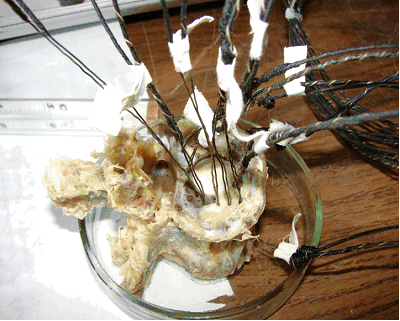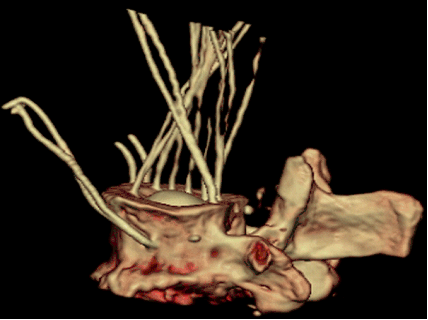|
|
JUSTIFICATION OF EFFECTIVENESS AND SAFETY OF THERMAL AND RADIATION THERAPY FOR CANCER
Simulation Systems Ltd carries out research of effectiveness and safety of thermal and radiation therapy for cancerous diseases, and, in particular, treatment of spinal column metastases, or stabilizing thermoradionuclide vertebroplasty. The suppression of tumor growth is achieved by combination of nidus exposure to local hyperthermal influence (41° – 60°C) and local irradiation by β-particles (or joint irradiation by β-particles and γ-photons). The β-particles are emitted by radioisotope homogeneously distributed in bone cement – polymethyl methacrylate, which is delivered to the tumor nidus in vertebral body by way of percutaneous vertebroplasty, offering the possibility to restore the supportive capacity of the vertebral column.
  Fig. 1. To the left is a photograph of a vertebra with thermocouples. To the right – three-dimensional reconstruction of vertebra sectional image with thermocouples
Fig. 1. To the left is a photograph of a vertebra with thermocouples. To the right – three-dimensional reconstruction of vertebra sectional image with thermocouples
Hyperthermal effect on tumor nidus is achieved by heat producing polymerization of bone cement. The cement is incorporated with a purpose built radionuclide, which then gets homogeneously distributed in the cement paste. The incorporation of bone cement into the tumorous vertebral body, which not only restores the supportive capacity of the vertebral column, but also is accompanied by hyperthermal influence and local irradiation by β-particles, has multifactor impact and produces palliative effect.
Fig. 2. Temperature at the center of the core and in the bone tissue at various proximities to the surface of the bone cement
The research scope comprises calculation and experimental studies with the aim of obtaining estimation and substantiation of effectiveness and safety of the proposed method.
Measurements of heat release and heat transport were taken in order to estimate the heating of the bone tissue; computational system capable of forecasting heat processes was suggested and approved.
Fig.3. Maximum temperature distribution at the bone tissue of the vertebra
Figure 1 displays a photograph and a three-dimensional reconstruction of vertebra sectional image with thermocouples. Figure 2 gives diagrams obtained through series of experiments of vertebra cavity being filled with bone cement. The diagrams illustrate the temperature-time relationship at the center of the cement core, at its surface adjoining the bone tissue, and in the bone tissue at various distances from the surface of the bone cement. The comparison of calculated distribution of maximum temperature with the one acquired through experiments is shown at Figure 3.
The research comprised suggestion of a calculation method for dose fields for selected radionuclide or their combination; the radiation dose received by radiosurgeon was substantiated.
|